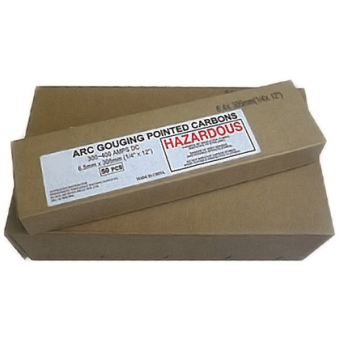Gouging Carbon
DC gouging carbons are made by mixing carbon/graphite with a binder, baking, and then coating with a controlled thickness of copper. Carbons are available in three types; Pointed, Jointed and Flat.
-
Pointed carbons are the standard all purpose gouging electrode. Controlled copper coaing improves electrical conductivity providing more efficient, cooler operation and helps maintain electrode diameter at the point of the arc.
-
Jointed carbons have the added bebefit of working wihout slub loss, with each rod having a female socket and matching male tang. They can be used with semi and fully automatic torches.
-
Flat carbons are specially designed for close tolerance metal removal and scarfing applications, producing a rectangular groove.
Air carbon arc gouging is done in the down hand, vertical, horizontal and overhead position with a stick out of 180mm and an electrode angle of approximately 35 degress, depending on th application.
The groove width obtained will be approximately 3mm wider than the carbon size.
The goughing action occurs when the arc is struck, removing molten metal as the electrde is moved along the work piece. A slow travel speed produces a deep groove, a fast travel speed produces a shallow groove.
The air flow must be turned on before gouging commences. The operator must ensure that adequate eye (shade 12-14), ear and clothing protection is worn.
Notes on Usage
-
Fast, clean, smooth hassel free gouging
-
Able to remove metal from a wide range of common ferrous & non ferrous metals
-
Designed for DC operation
-
Superior arc stability
Gouging carbons are used for the efficient gouging, back gouging and plate edge preparation, touching up and remova of old or defective hardfacing and stainless steel weld deposits. They are used for reworking plates, dies, castings, pipes, armour plating etc. they gouge and sever ferrous and non ferrous metals such as carbon steel, low alloy steel, cast iron, nickel alloys (nickel less than 80%), magnesium alloys and aluminium on DCEP. Copper alloys, aluminium bronze alloys and aluminium nickel bronze alloys can be gouged using DCEN.
Air carbon arc welding is used in many industries such as agriculture, automotive, heavy fabrication, construction, foundaries, maintenance and repair shops, minimg and quarrying, military, shipyards, power plants, railroads, steel mills to name a few.
Conditioning Data
If carbons are damp, they should be re dried at 180ºC for 10 hours, otherwise they may shatter.






